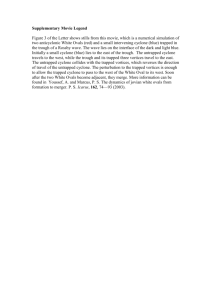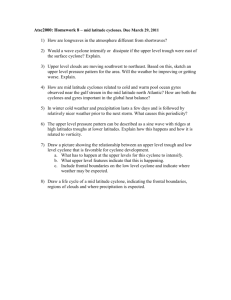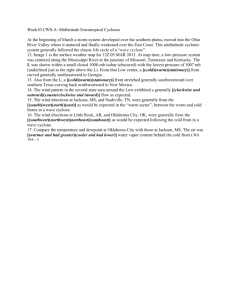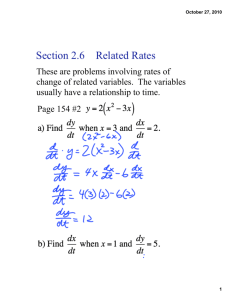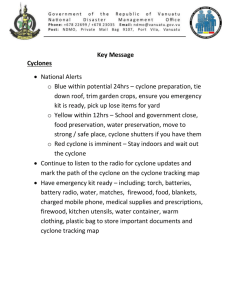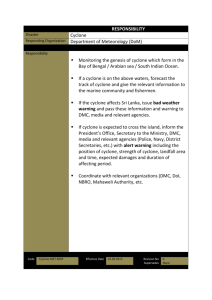PPT
advertisement
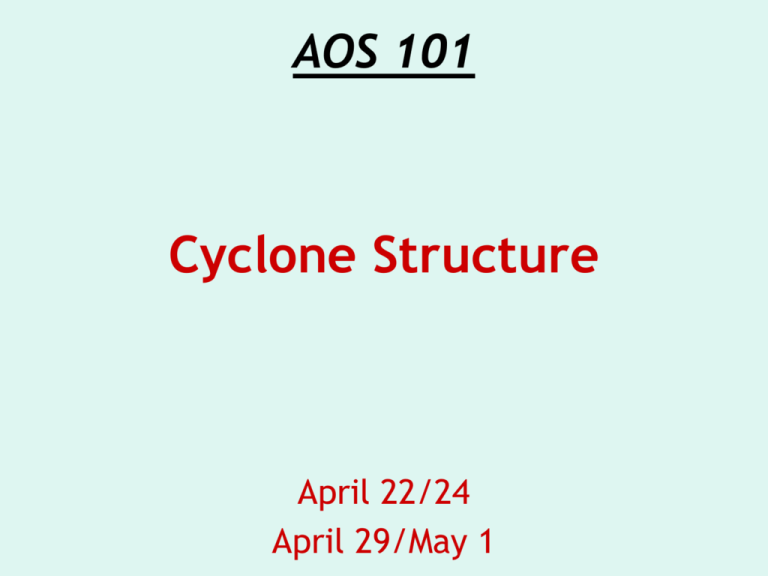
AOS 101 Cyclone Structure April 22/24 April 29/May 1 Cyclone • Symbols: • Point in direction of front movement COLD WARM OCCLUDED STATIONARY Warm Front WARM COOL Associated Weather (WF) • Gradual Slope • Stratiform rain – long lasting light rain – occurs on cool side of front • Temperature increases prior to frontal passage • Wind becomes southerly after passage Cold Front WARM COOL Associated Weather (CF) • Much Steeper Slope • More intense (convective) rain – Thunderstorms for a shorter period – occurs on warm side of front • Temperature decreases after frontal passage • Wind becomes northerly after passage COOL AIR L LIGHTER RAIN COLD AIR WARM AIR HEAVIER RAIN Finding a Front • Temperature (dewpoint) Gradient • Change in wind direction – Converging winds at the front • “Kink” or “trough” in isobars (lower pressure) • Banded precipitation Horizontal Cyclone Structure Cyclone Life Cycle • • • • • • Stationary Front Wave Cyclogenesis Maximum Intensity Occluding Dissipation Stationary Front • North-to-south temperature gradient • Winds parallel to the front COLD WARM Wave • Winds gain a northerly/southerly component • Wave forms on the front • Usually caused by an upper-level trough (next week) COLD WARM Cyclogenesis • Closed cyclonic circulation froms • Surface pressure minimum is observed • Cold fronts and warm fronts become distinct COLD L WARM Maximum Intensity • Warm air overruns cold air at warm front • Cold air quickly moves around to the south • Cold front moves faster, “catches” warm front • Storm deepens to lowest pressure L COLD WARM Comma Head Occlusion • Cold front catches warm front leaving warm air aloft • Cold air encircles cyclone center • Another cyclone may form at triple point L L COLD WARM Occluded Front WARM COLD COOL Dissipating • Cold air completely encircles low • All warm air is pushed aloft • Cyclone can no longer feed off of temperature differences Vertical Cyclone Structure Upper-level terminology • TROUGH: area of lower heights • RIDGE: area of higher heights L H Vorticity Advection • VORTICITY: how much the flow curves • Trough = positive; Ridge = negative L POSITIVE VORTICITY NEGATIVE VORTICITY H • Downwind of trough axis = Positive V.A. • Downwind of ridge axis = Negative V.A. L NEGATIVE VORTICITY POSITIVE VA H NEGATIVE VA Mechanisms for Deepening Cyclones • Warm air advection (WAA) near the ground – Look at surface temperature and winds • Positive vorticity advection (PVA) at upper levels – Look at upper-level (e.g. 500 hPa) winds and trough/ridge axes. • Both promote upward vertical motion (ascent). Vertical Structure: Beginning PVA POSITIVE VORTICITY STATIONARY FRONT Vertical Structure: Cyclogenesis WAA L POSITIVE VORTICITY Westward tilt with height Vertical Structure: Occlusion L PVA POSITIVE VORTICITY WAA EXAMPLE 0000 UTC 10 November 1998 300 mb flow which resulted in a massive cyclone development over the midwest. PVA downwind of trough PVA TROUGH AXIS 300 hPa Height, Wind Speed EXAMPLE 0000 UTC 10 November 1998 Weak cyclone downwind of trough Fronts are relatively weak L TROUGH AXIS Surface Pressure, 500-1000 Thickness EXAMPLE 1200 UTC 10 November 1998 12 hours later… Trough moves west, strong jet rotates around trough PVA TROUGH AXIS EXAMPLE 1200 UTC 10 November 1998 Cyclone has deepened to 977 hPa, has moved closer to trough axis. Intense WAA north of cyclone L TROUGH AXIS EXAMPLE 0000 UTC 11 November 1998 12 hours later… Trough is now cutoff PVA TROUGH AXIS EXAMPLE 0000 UTC 11 November 1998 Surface cyclone practically under trough axis i.e. The cyclone is “vertically stacked.” L TROUGH AXIS No PVA or WAA = no more intensification Main Points • Cyclones will tend to form downwind of an upper-level trough in an area of PVA. • As the cyclone develops, WAA will occur on the warm front further deepening the cyclone • Whole system will tilt westward with height • While developing, cyclone will move closer to trough axis • While occluding, cyclone will move nearly under trough axis in an area void of PVA/WAA.
